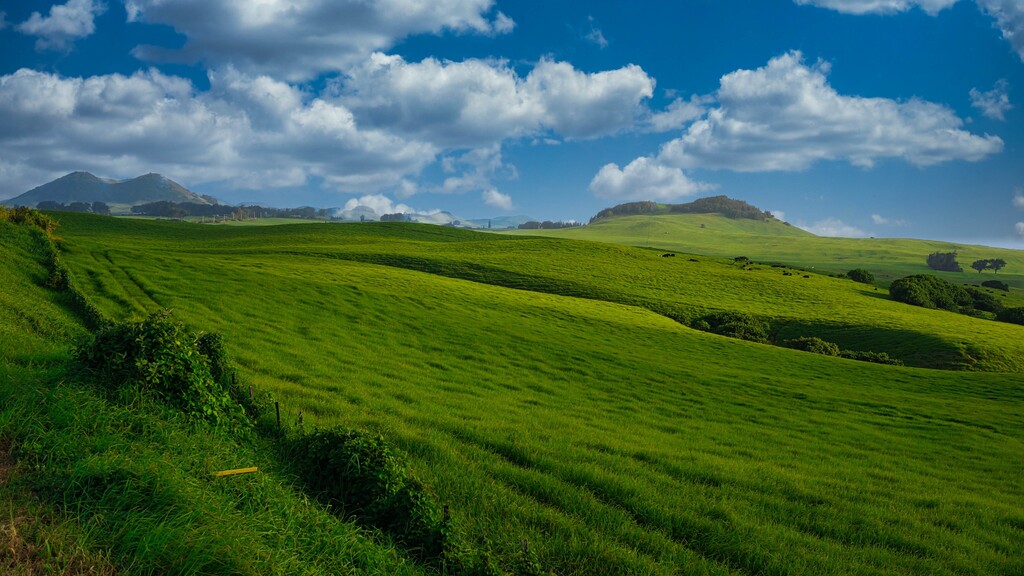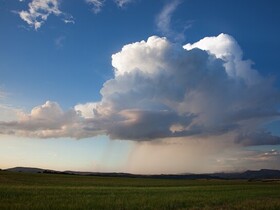


Carbon sequestration in grasslands refers to above ground and below ground biomass through roots, but mainly soil sequestration.
Carbon sequestration potential of permanent pastures worldwide is estimated to be between 0.01 and 0.3 Gt C yr-1, but; ‘Uncertainty for grasslands are approximately twice those for forests.’ Grassland management involves planned cutting of biomass, as well as both natural and manmade fires, which emit carbon and reduce above ground carbon sequestration for periods of time.
Grasslands also change over time through a redirection from arable land back to grassland and vice versa and the stage of their growth is a key factor in their ability to sequester carbon. Temperate and tropical grasslands were researched globally, to try and determine their carbon sink rates over a range of areas and ecosytems.
There is significantly more data available for managed grasslands through agriculture, than non-managed. There is also a large amount of data for American grasslands and croplands, with large areas of the country given over to arable crops. The age of the grassland makes some effect as to its capacity for carbon storage. Older grasslands have greater capacity for sequestration than younger grasslands, but are likely to have had more interference through land management over time.
Other grasland types which have been investigated are savannas and steppes which are often influenced by grazing.
The carbon cycle is presented and influencing factors such as land use changes and management practices are analysed. mehr
Looking at where the carbon actually is, within the carbon cycle in grasslands and exploring how effective carbon sequestration is, through modelling and measuring pools and fluxes.
In this article the processes of carbon sequestration are described and the influences of management, climate change and increased CO2 levels on the future carbon sequestration are assessed. mehr
The substantial stocks of carbon sequestered in temperate grassland ecosystems are located largely below ground in roots and soil. Organic C in the soil is located in discrete pools, but the characteristics of these pools are still uncertain. Carbon sequestration can be determined directly by measuring changes in C pools, indirectly by using simulation modelling. Measured and modelled rates of C sequestration range from 0 to > 8 Mg C ha−1 yr −1. Management practices, climate and elevated CO2 strongly influence C sequestration rates and their influence on future C stocks in grassland soils is considered.
Currently there is significant potential to increase C sequestration in temperate grassland systems by changes in management, but climate change and increasing CO2concentrations in future will also have significant impacts. Global warming may negate any storage stimulated by changed management and elevated CO2, although there is increasing evidence that the reverse could be the case.
Original Studies:
1. Schulze, E‐D., Riccardo Valentini, and M‐J. Sanz. "The long way from Kyoto to Marrakesh: implications of the Kyoto Protocol negotiations for global ecology." Global Change Biology 8.6 (2002): 505-518.
2. Post, Wilfred M., and Kyung C. Kwon. "Soil carbon sequestration and land‐use change: processes and potential." Global change biology 6.3 (2000): 317-327.
3. Follett, R. F., J. M. Kimble, and R. Lal. The potential of US grazing lands to sequester soil carbon. Lewis Publishers, Boca Raton, Florida, 2001
In this study the impact of age and different management practices on carbon sequestration and emissions is analysed. mehr
Grasslands are potential carbon sinks to reduce unprecedented increase in atmospheric CO2. Effect of age (1–4-year-old) and management (slurry, grazing multispecies mixture) of a grass phase mixed crop rotation on carbon sequestration and emissions upon cultivation was compared with 17 year old grassland and a pea field as a reference. Above ground and root biomass were determined and soils were incubated to study CO2 emissions after soil disturbance.
There was a substantial increase in root biomass with age but indifference in CO2 emissions across the age and management in temporary grasslands, thus, indicating potential for long-term sequestration of soil carbon.
This report provides information on carbon sequestration of many ecosystems (e.g. grassland) in Western US and tries, on the basis of a baseline scenario, to assess the carbon sequestration till 2050. mehr
Carbon storage and flow and GHG fluxes were examined in the Western United States for major terrestrial ecosystems (forests, grasslands/shrublands, agricultural lands, and wetlands) and aquatic ecosystems (rivers, streams, lakes, estuaries, and coastal waters) in two time periods: baseline (the first half of the 2000s) and future (projections from baseline to 2050).
In this study the benefits of land use changes (e.g. conversion of agricultural areas in grassland) regarding carbon sequestration are calculated. mehr
The review and analyses presented here focus on two potential land use change (LUC) project activities: (1) avoided conversion of threatened grasslands (AGC), and (2) conversion of marginal cropland to grassland (CCG). This Issue Paper characterizes and evaluates these activities as potential carbon offset project types within the United States.
The carbon storage in orchards is calculated in this study. mehr
To calculate the total carbon of a plot, the soil carbon down to a depth of 60 cm was converted into carbon per square meter and the above ground carbon, namely the carbon provided by the trees, was added. This resulted in soil organic carbon values between 7.58 kg C m-2 or 75.79 Mg C ha-1 and 19.48 kg C m-2 or 194.79 Mg C ha-1. A comparison of the mean soil carbon values for each land use showed that the land use field had the lowest value of 7.58 kg C m-2 and pasture the highest with 13.09 kg C m-2 while the mean soil carbon value for streuobst was slightly lower with 12.51 kg C m-2. All in all, tree carbon amounted to a mean share of 14.15 % on total carbon.
When the above ground carbon from the trees is added to the soil carbon, all places had a higher carbon content on the streuobst orchards except for place R1. Maximum values here were 22.04 kg C m-2 or 220.4 Mg C ha-1 at place B1 and 16.93 kg C m-2 or 169.3 Mg C ha-1 at place K2. The arithmetic mean of the streuobst carbon increased to 14.68 kg C m-2 or 146.7 Mg C ha-1, therewith being higher than the one for pasture of 12.51 kg C m-2 or 125.1 Mg C ha-1. The standard deviation for both mean values was 4.65 for streuobst and 4.92 for pasture.
In this report different practices are named which can reduce the emissions and improve the carbon sequestration. mehr
Implementing grassland management practices that increase carbon uptake by increasing productivity or reducing carbon losses (e.g. through high rates of offtake) can lead to net accumulation of carbon in grasslandsoils – sequestering atmospheric carbon dioxide (CO2).
Globally, the potential to sequester carbon by improving grassland practices or rehabilitating degraded grasslands is substantial – of the same order as that of agricultural and forestry sequestration. Because practices that sequester carbon in grasslands often enhance productivity, policies designed to encourage carbon sequestering grassland management practices could lead to near-term dividends in greater forage production and enhanced producer income.
This study is on the contribution of the global area of grassland and savannas to carbon sequestration. mehr
The challenge to identify the biospheric sinks for about half the total carbon emissions from fossil fuels must include a consideration of below-ground ecosystem processes as well as those more easily measured above-ground. Recent studies suggest that tropical grasslands and savannas may contribute more to the ‘missing sink’ than was previously appreciated, perhaps as much as 0.5 Pg (5 0.5 Gt) carbon per annum.
The carbon sequestration of the savanna ecosystem plays an important role for the climate protection. This study analyses single carbon fluxes and components of this ecosystem. mehr
Through estimations of above- and belowground standing biomass, annual biomass increment, fine root production and turnover, litterfall, canopy respiration and total soil CO2efflux, a carbon balance on seasonal and yearly time-scales is developed for a Eucalypt openforest savanna in northern Australia. This carbon balance is compared to estimates of carbon fluxes derived from eddy covariance measurements conducted at the same site. The total carbon (C) stock of the savanna was 204±53 ton C ha1, with approximately 84% belowground and 16% above-ground.
This study provides many numbers and information on primary production and carbon fluxes in savannas. Additionally the importance of protecting these ecosystems from fires becomes apparent. mehr
Tropical savannas can be remarkably productive, with a net primary productivity that ranges from 1 to 12 t C ha^-1 year^-1 .The carbon sequestration rate (net ecosystem productivity) may average 0.14 t C ha^-1 year^-1 or 0.39 Gt C year^-1 . If savannas were to be protected from fire and grazing, most of them would accumulate substantial carbon and the sink would be larger.
Savannas are under anthropogenic pressure, but this has been much less publicized than deforestation in the rain forest biome. The rate of loss is not well established, but may exceed 1% per year, approximately twice as fast as that of rain forests. Globally, this is likely to constitute a flux to the atmosphere that is at least as large as that arising from deforestation of the rain forest.
The impact of extensive grazing on the carbon balance is investigated on two adjacent areas in China. mehr
In this study, in situ net ecosystem CO2 exchange (NEE) observations by the eddy covariance technique were integrated with a modified process-oriented biogeochemistry model (denitrification–decomposition) to investigate the impacts of grazing on the long-term C budget of semiarid grasslands. Moderate grazing prevails over no-management practices in maintaining CO2 balance in semiarid grasslands, moderating and mitigating the negative effects of global climate change on the CO2 balance in grassland ecosystems.
For different plots the vegetation and carbon storage in the above ground parts of the plant and of the soil were determined. mehr
Total carbon storage measured in these steppes (43,372 kg ha^–1) constitutes a very high mean value linked to the fact that the bulk (43,000 kg ha^–1 or 93%) of the carbon stored in our steppic areas is underground carbon. The denser stand from this area presents an above-ground phytomass close to 17,000 kg ha^–1 or 6770 kg of carbon ha^–1. In this particular plot, soil is very deep (about 200 cm), without gypsiferous crust and with values of organic carbon ranging from 1·4% in the 0–20 cm layer to 0·8% in the 170–200 cm layer. Thus, underground storage is very high, close to 199·7 T ha^–1, and with total carbon storage reaching 206 T ha^–1, this constitutes a very considerable value (Le Hou´erou, pers. comm.).
Degradation due to humans and livestock decreases above-ground phytomass, resulting in a loss of underground carbon storage in connection with the depletion of litter and erosion processes and the subsequent decreased supply of organic matter to the soil.